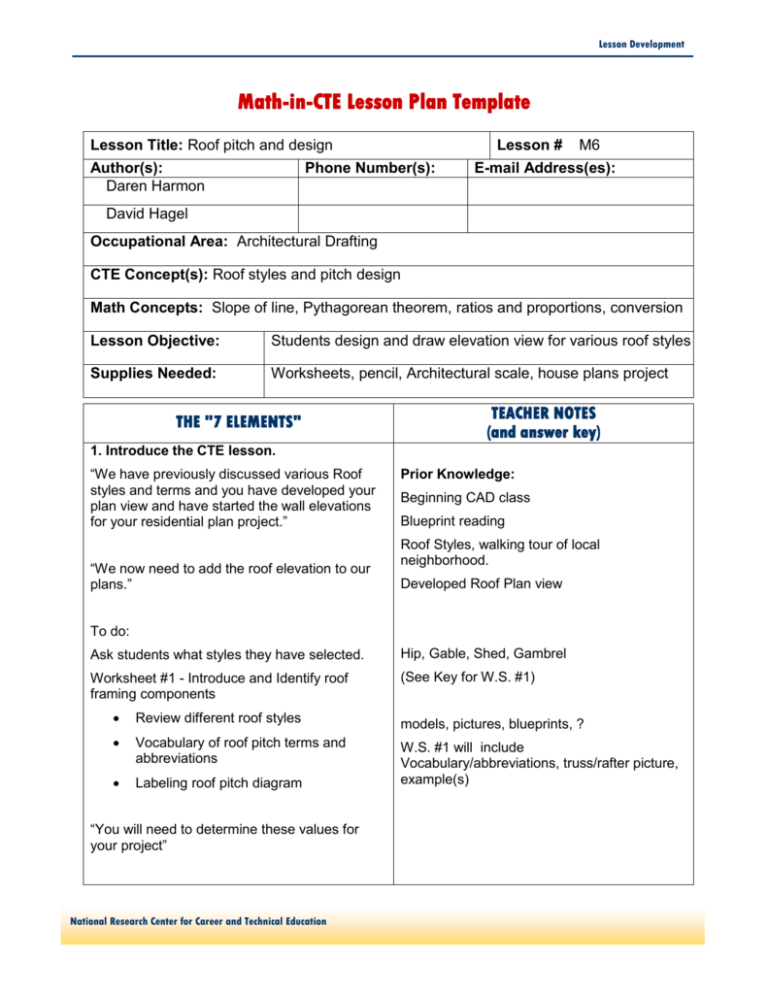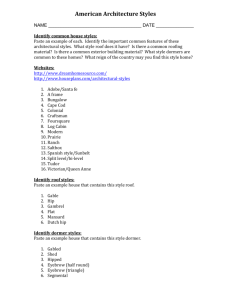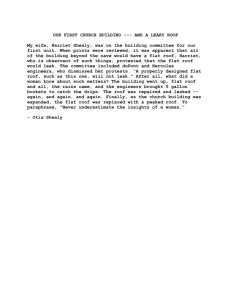Roofs - Lesson Plan
advertisement

Lesson Development Math-in-CTE Lesson Plan Template Lesson Title: Roof pitch and design Author(s): Daren Harmon Lesson # Phone Number(s): M6 E-mail Address(es): David Hagel Occupational Area: Architectural Drafting CTE Concept(s): Roof styles and pitch design Math Concepts: Slope of line, Pythagorean theorem, ratios and proportions, conversion Lesson Objective: Students design and draw elevation view for various roof styles Supplies Needed: Worksheets, pencil, Architectural scale, house plans project THE "7 ELEMENTS" TEACHER NOTES (and answer key) 1. Introduce the CTE lesson. “We have previously discussed various Roof styles and terms and you have developed your plan view and have started the wall elevations for your residential plan project.” “We now need to add the roof elevation to our plans.” Prior Knowledge: Beginning CAD class Blueprint reading Roof Styles, walking tour of local neighborhood. Developed Roof Plan view To do: Ask students what styles they have selected. Hip, Gable, Shed, Gambrel Worksheet #1 - Introduce and Identify roof framing components (See Key for W.S. #1) Review different roof styles models, pictures, blueprints, ? Vocabulary of roof pitch terms and abbreviations Labeling roof pitch diagram W.S. #1 will include Vocabulary/abbreviations, truss/rafter picture, example(s) “You will need to determine these values for your project” National Research Center for Career and Technical Education Lesson Development 2. Assess students’ math awareness as it relates to the CTE lesson. “Your assignment will require you to find missing values to several different roof truss styles. You may use any past experiences or knowledge to complete it. Please show all work.” Given the rise and run, the W.S. will include calculating rafter length, pitch, unit rise(Uri), unit run (URu is always 12), and unit line length (ULL). Worksheet #2 3. Work through the math example embedded in the CTE lesson. “Out of the Vocabulary terms from worksheet #1, which have we NOT yet used?” “Get out W.S. #2, and sketch extension and dimension lines showing Rafter Length.” Bridge question: Rafter Length(RL), Unit Line Length(ULL) Refer to W.S. #1 for extension/dimension lines. “How could we find these two lengths?” RL, ULL Pythagorean Theorem. a 2 b 2 c2 Instruction – Work example Split truss samples down middle, add right angle symbol on examples. Worksheet #3 (back of W.S. #2) Find the Rafter length(RL) and Unit line length (ULL) - Pythagorean Theorem “(1) Turn your paper over (W.S. #2) and with straight edge, draw the span and the roof line to form a large triangle. (2)Now draw a vertical line from the roof peak to the span line to split this triangle in two.” “(3)What is the angle that this line makes with the span line?” ( 90 or right angles) “We now have two right triangles” (4) Place a, b, c according to the Pythagorean thm. with a and b as legs of right triangle and c is the hypotenuse. National Research Center for Career and Technical Education a, b are legs of right Triangle, c is the hypotenuse. Lesson Development From the Pythagorean theorem we know that a 2 b2 c2 a 2 b2 c2 . c2 a 2 b2 If we solve for c, we get c a 2 b 2 “But we have different names for a, b, and c. What are they? c2 a 2 b2 c a b 2 2 example: pick a number, 7 so what is the square root of 7 squared? 7 2 49 7 a is Total Rise(TRi), b is Run, and c is Rafter length(RL) “If we substitute our terms for a, b, and c, then we get RL TRi 2 run 2 ” Example #1- Room-in-attic “Substitute 20 for TRi, 24 for run and calculate the Rafter length(RL). We want the answers in feet and inches. 31.24 feet equals 31’ 2.88”. We should round to the nearest 1/8th in. Say 31’ 2 7/8” Example #2 –Scissors RL 82 162 RL 64 256 3 RL 19.70 feet = 19' 8 " 8 Example #3 – Vault RL 19.5 feet = 19' 6" National Research Center for Career and Technical Education RL 320 5 RL 17.89 feet = 17' 10 " 8 RL 7.52 182 RL 56.25 324 RL 380.25 RL 19.5 feet = 19' 6" Lesson Development Example #4 – Dual Pitch (Work to come later) 4. Work through related, contextual math-inCTE examples. Review question: Total Rise(TRi) divided by the Run. “What is the definition of pitch?” Bridge question: Slope (of a line) “What is pitch called in a Math class?” “In math class, the slope is defined as the rise divided by the run, which is exactly what we have just been doing.” “What other real life applications do we come across the concepts of slope/pitch?” Related contextual CTE example(s) Drainage, ramps, landscape, stairs, bracing, driveways, patios, streets, etc. Worksheet #4 #1 Ramp Problem Rise of the Ramp – use proportions What are we tying to find, and how are we going to do it? Ramp length – Use Pythagorean thm. #2 Drainage Problem Length of drainage pipe needed from cleanout to main sewer line. – Students will need to calculate the total drop(proportions) and then use it to find pipe length using Pyth. Thm. What are we tying to find, and how are we going to do it? (work to come later) (work to come) National Research Center for Career and Technical Education Lesson Development #3 Stair Problem What are we tying to find, and how are we going to do it? Find unit rise (length of tread) and the unit run(height of riser). - proportions Stringer length – Pythagorean thm. 5. Work through traditional math examples. Worksheet #5 Proportion Problems Conversion Problems Right Triangle Problems (Pythagorean thm.) 6. Students demonstrate their understanding. Students complete roof elevation on own house plans. 7. Formal assessment. Quiz on figuring pitch and rafter length. (To come later) National Research Center for Career and Technical Education (answer key to come later) All work will be completed on student residential house plans. (To come later)





